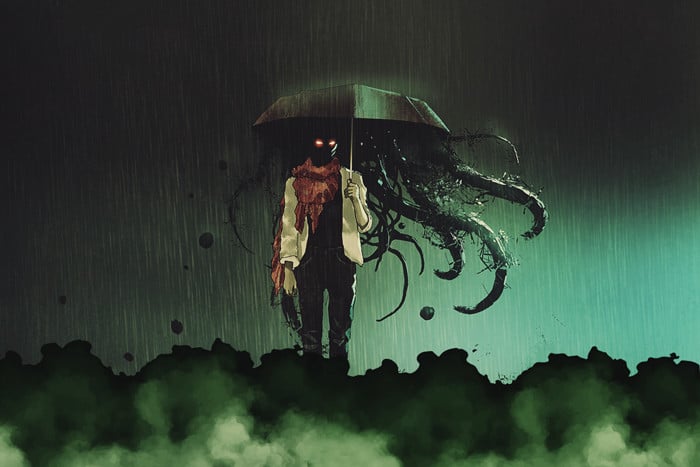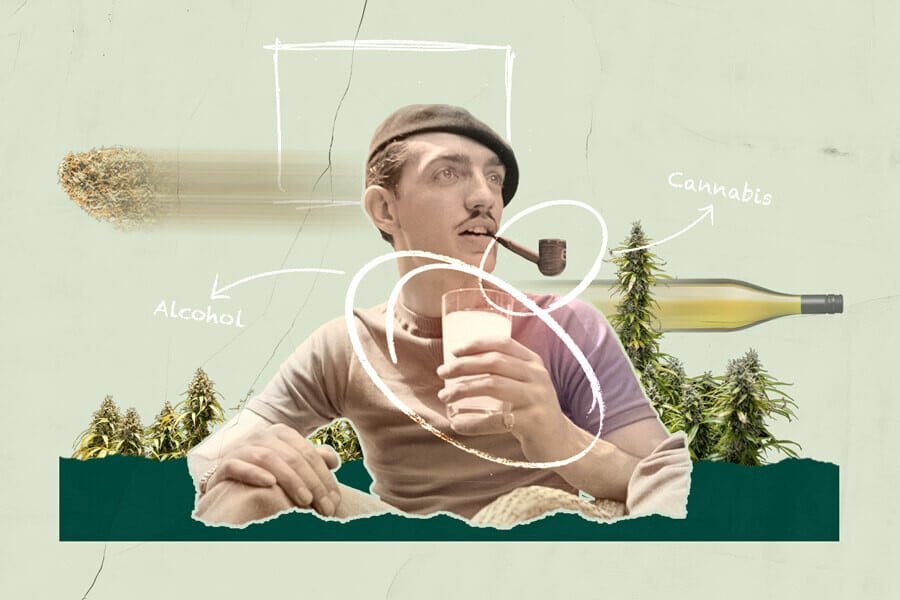.
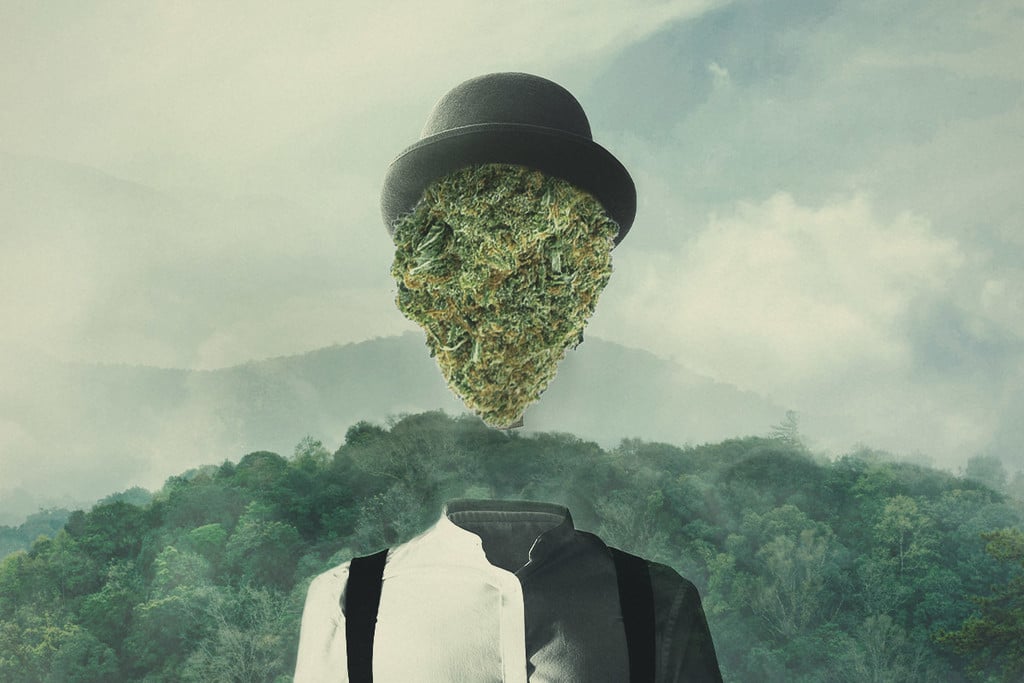
Cannabis effects: Why Weed Gets You High
Nowadays, it seems like nearly everyone’s tried some form of cannabis at least once. But, if you haven’t, we understand. The idea of being high can be intimidating, and no one should pressure you into trying it. That being said, if you’re considering trying weed, you should learn how it might make you feel, and what causes those feelings in turn.
We’ll break down how it feels to be high, and show you how THC affects the brain.
Contents:
- Chemistry of the cannabis high
- What does it feel like to be high?
- How to tell when you’re high
- Stages of the cannabis high
- Different strains offer different highs
- Cbd high vs. thc high
- Different methods of consumption lead to different highs
- Mind high vs. body high
- Why do people think differently when high?
Humans have used cannabis for its psychoactive properties for thousands of years. But how, exactly, does this product of nature alter our perceptions? As you read on, we’ll walk you through the details of how cannabis affects our minds, and show you how it’s able to do it all.
Chemistry of the Cannabis High
To understand how cannabis makes you high, you have to take a closer look at what you’re toking on.
If you’ve looked at some cannabis flowers, you’ve probably noticed the small, shiny, and crystalline glands covering them. These small glands are known as trichomes, and they produce a viscous resin rich in cannabinoids and terpenes.
Through the years, growers have bred their cannabis strains to produce resin high in one particular cannabinoid. That one, of course, is THC—the primary psychoactive cannabinoid. It doesn’t just take effect right after gaining entry to the bloodstream, though. The molecule, in fact, acts on very specific receptor sites to make you feel high.
Just as all of our bodies have a nervous system, we also all possess an endocannabinoid system[1], known as the ECS for short.
This regulatory system oversees the functions of much of our physiology, keeping everything in balance. It consists of cannabinoid receptors and endocannabinoids[2]—signalling molecules that bind to these receptors.
As one of the major endocannabinoids in the body, anandamide binds to both the CB1 and CB2 receptors[3]. When it binds to the former, it induces a warm mood and positive emotion, earning it the title of “bliss molecule”. Supporting this status, scientists believe anandamide lies at the root of the euphoric “runner’s high[4]” experienced by athletes after aerobic exercise.
THC shares a similar molecular structure to anandamide. Because of this, it mimics the endocannabinoids in the body and binds to the CB1 receptor, inducing similar blissful effects.
If you’re smoking it, THC diffuses through the alveoli of the lungs and into the bloodstream. It blazes past the blood-brain barrier and begins latching onto the CB1 receptors on neurons throughout the brain, leading to a surge in dopamine production[5].
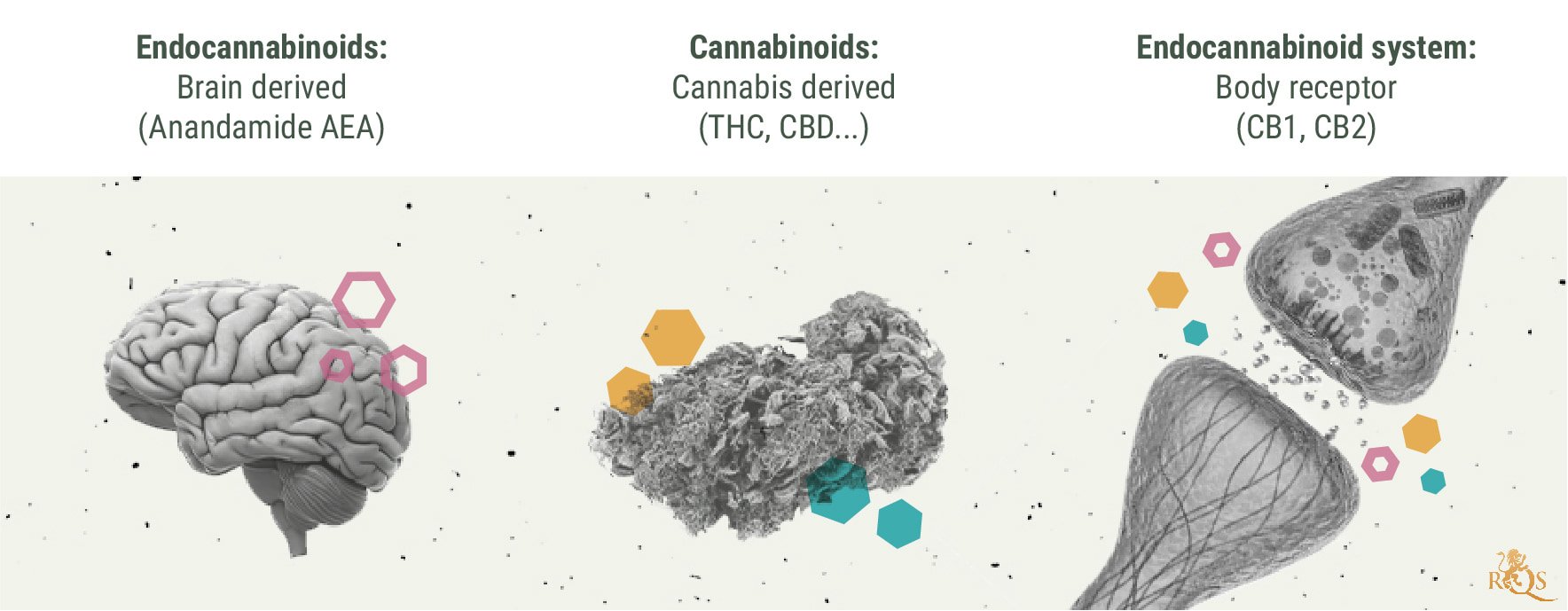
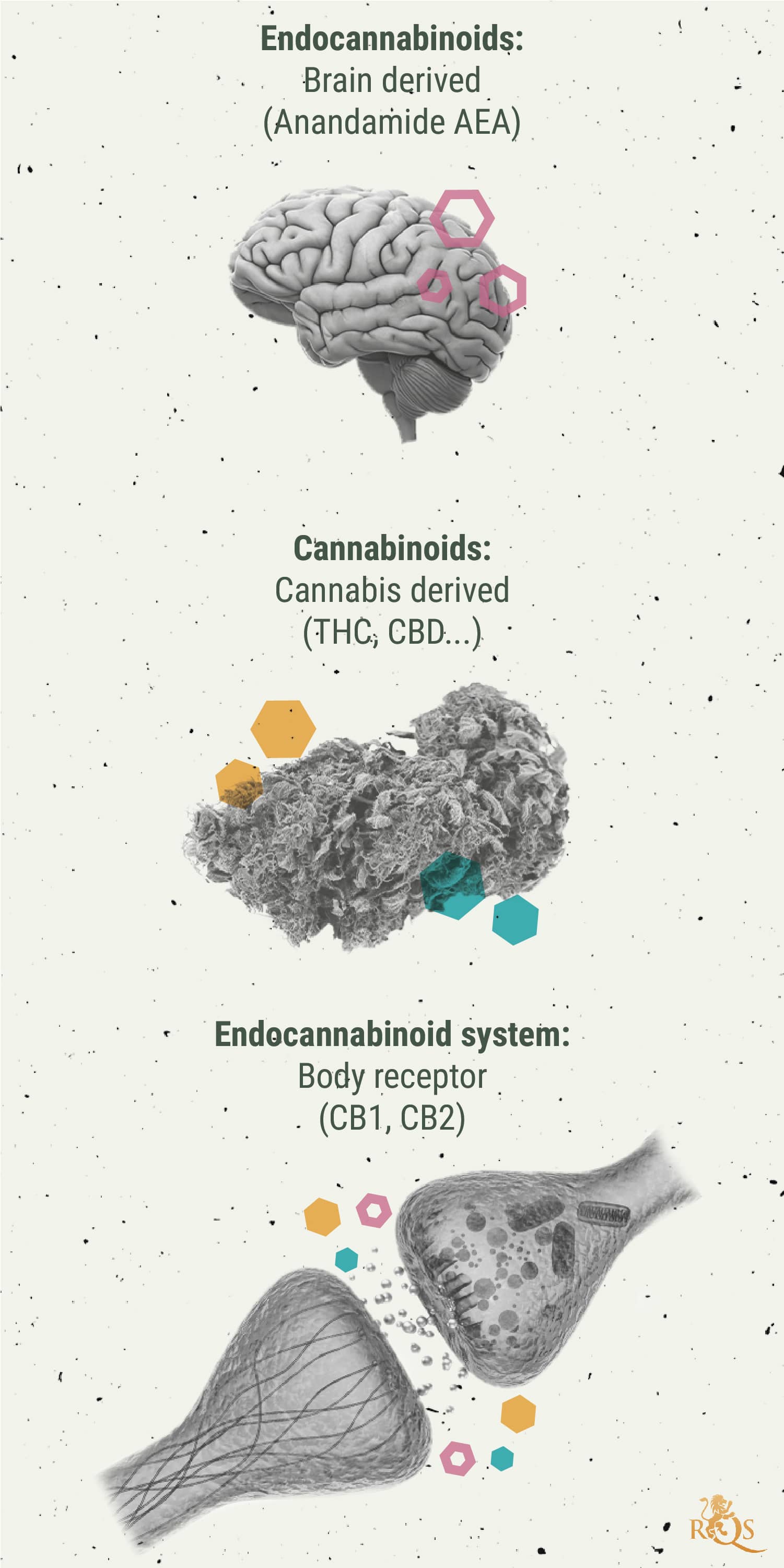
The Movement of Cannabinoids in the Body
Smoked or vaped THC enters the bloodstream through diffusion—the movement of a substance from an area of high concentration to one of low concentration. Specialised tissues in the lungs called alveoli allow for the exchange of oxygen and carbon dioxide via diffusion, and THC also takes advantage of this passageway into systemic circulation.
But inhalation isn’t the only way to introduce THC into the body. Edible cannabis sends the cannabinoid through the stomach and liver—a route known as first-pass metabolism[6]. This process converts THC into an even more potent molecule named 11-hydroxy-THC.
Inhaled THC enters the bloodstream within a matter of seconds, whereas the throes of the digestion mean the high takes much longer to set it. Regardless of this difference in timing, both THC and 11-hydroxy-THC end up in the same place. Systemic circulation shuttles both of these compounds off toward the blood-brain barrier, and each of these fat-loving molecules is small enough to gain entry through this semi-permeable border to the command centre of the central nervous system.
Once they arrive at their destination, these molecules get to work changing how our neurons fire. The way we perceive everyday reality depends on the routine firing of neurotransmitters such as gamma-aminobutyric acid (GABA), glutamate, dopamine, serotonin, and other key chemicals. But these molecules don’t maintain our normal state of consciousness through chaotic synthesis, release, and degradation—a finely tuned system helps to keep all of this under control.
-
The Role of the ECS
The endocannabinoid system (ECS) is tasked with governing the flow of various neurotransmitters from one neuron to the next. Cannabinoids such as THC also happen to interface with this body-wide network of receptors, enzymes, and signalling molecules to catalyse effects.
Now, take a second to rummage around in your noggin' for the file labelled "biology" from your school days; you might remember how synapses work. These structures are the communication points between neurons, and are made up of the axon of the presynaptic neuron, the dendrite of the postsynaptic neuron, and the synaptic cleft (the gap between the two).
Almost all neurotransmitters travel in an “anterograde” fashion, meaning they travel across the presynaptic cleft from the presynaptic neuron to the postsynaptic neuron. However, as the traffic controller of this system, the ECS sends its signalling molecules, known as endocannabinoids, backwards across the synaptic cleft in a “retrograde” fashion[7]. This opposite flow of movement allows endocannabinoids to bind to receptors on the presynaptic neuron and control the amount of neurotransmitters they send over the cleft.
Now, here’s where THC steps in. This psychotropic cannabinoid mimics the action of our endocannabinoids. After gaining access to the brain, the molecule docks to the landing pads that are ECS receptors, effectively controlling the flow of neurotransmitters. But instead of acting like the normal endocannabinoids in the brain, THC and its metabolites come in like a wave, flooding the ECS and altering neurotransmitter firing.
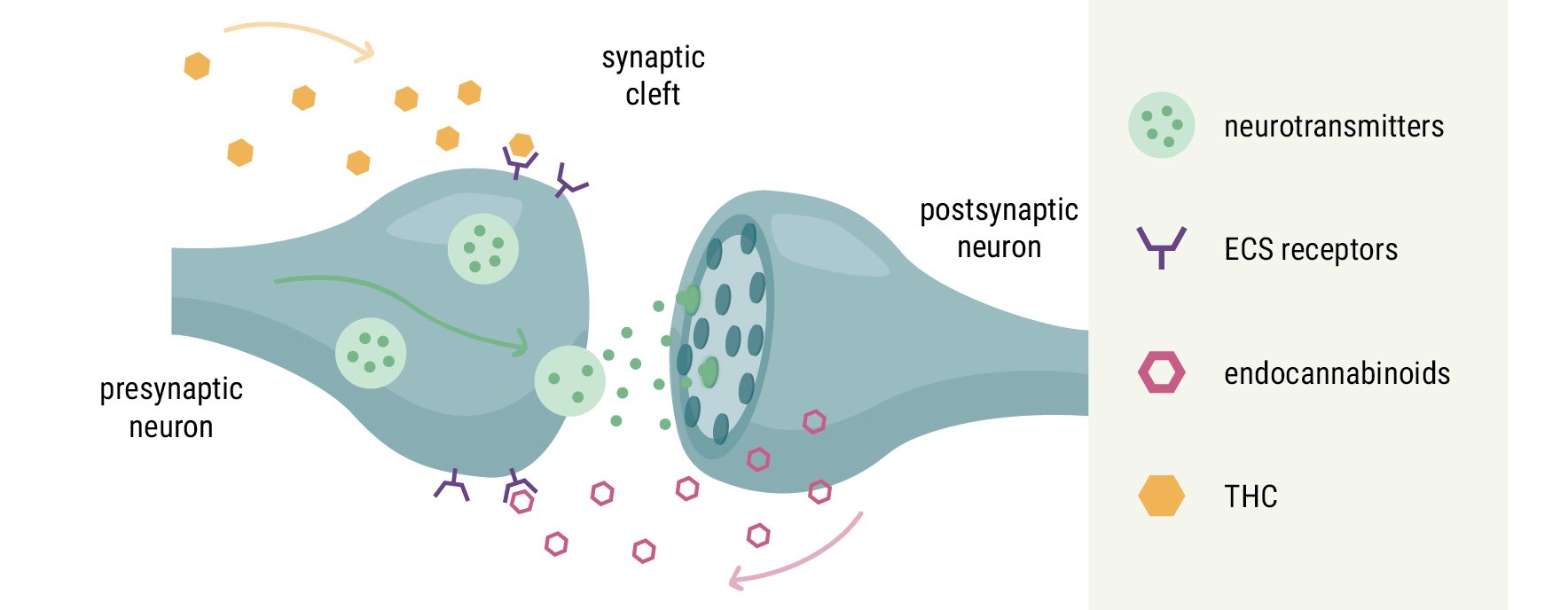
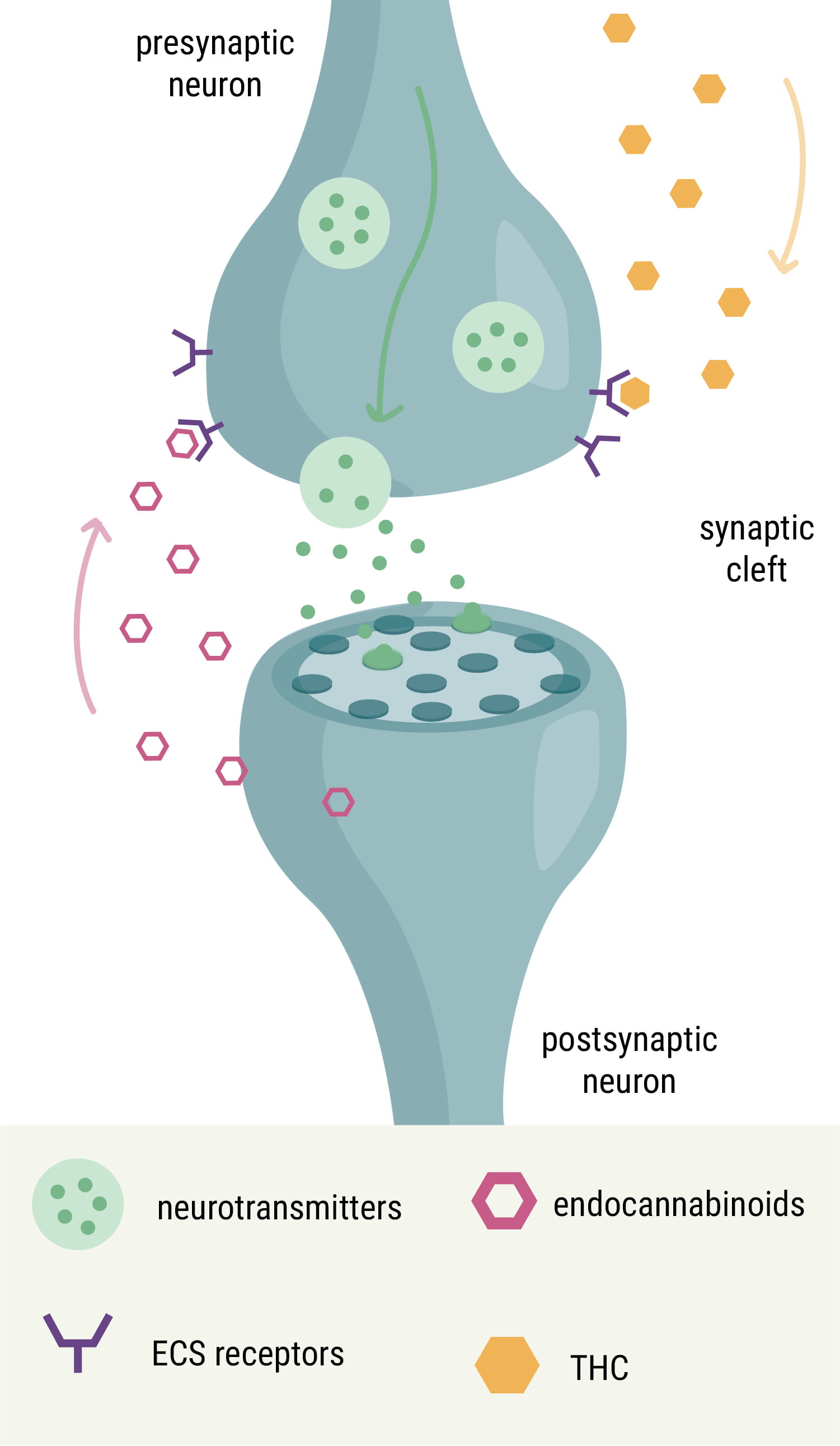
Now, take this mechanism of action and apply it to the 85 billion neurons and 100 trillion connections between them in the human brain, and it’s no wonder cannabis makes us feel so euphoric and heightens tastes, sounds, and sights!
Researchers are still trying to figure out exactly what THC does here, and how it tweaks certain brain chemicals. However, they’re fairly certain that the cannabinoid deactivates or “unplugs” the default mode network (DMN)[8].
The DMN consists of an interconnected series of brain regions that activate when we’re at rest. This network allows us to daydream, ponder our past, and get lost in thought. However, engaging in a task that requires concentration shuts this network down and enables us to focus specifically on what’s in front of us.
By unplugging the DMN, THC enables us to see normal and mundane things in a different light. This might explain why nature appears so wondrous when stoned, and why music, food, and films have a much more profound effect on us when high.
What Does It Feel Like to Be High?
All this science talk is fine, but it won’t tell you how using weed will actually make you feel.
Although THC acts on the same biochemical pathways in everyone, many factors come into play that modulate the experience. As a result, people will experience different highs from the same dose of THC, even when they’re smoking the same strain. That being said, the cannabis high is marked by a few common experiences. These include:
| Elevated mood | Increased hunger | Falling deep into though |
| Enhanced creativity | Increased sociability | Frequent laughter |
| Elevated mood | Increased hunger |
| Falling deep into though | Enhanced creativity |
| Increased sociability | Frequent laughter |
Being high certainly takes some getting used to. However, after the first few tries, you’ll start to feel much more comfortable in the altered state of consciousness. Music sounds more pleasant, food tastes immaculate, and movies will drag you into the depths of their storylines.
For many people, cannabis helps them be more talkative, confident, and able to express abstract ideas. Most cannabis users will agree: some of the best conversations they ever took part in involved copious amounts of the herb.
How to Tell When You’re High
You’ll know the effects of THC are setting in as you start to feel “different”. Many of these cognitive changes are positive, but others are negative and can leave users feeling uneasy.
Pleasant Sensations
When you’ve had an ideal dose in the right circumstances, you’ll mainly enjoy the pleasant effects of being high. These sensations include:
| Happiness | Euphoria | Cognitive clarity | |||||
| Increased mental activity | Enhanced creativity | The “giggles” | |||||
| Enhanced touch, taste, smell, hearing, and sight | |||||||
|---|---|---|---|---|---|---|---|
| Happiness | Euphoria | ||||||
| Cognitive clarity | Increased mental activity | ||||||
| Enhanced creativity | The “giggles” | ||||||
| Enhanced touch, taste, smell, hearing, and sight | |||||||
|---|---|---|---|---|---|---|---|
Unpleasant Sensations
Every now and then, though, being high can get unpleasant, especially if you take a higher dose than normal. Other times, however, you might just be in a bad mindset or feeling on edge due to your settings. These unpleasant sensations can include:
| Anxiety | Confusion | Panic |
| Paranoia | Increased heart rate | Psychosis (in very rare cases) |
| Anxiety | Confusion |
| Panic | Paranoia |
| Increased heart rate | Psychosis (in very rare cases) |
Stages of the Cannabis High
Although everyone experiences being high differently, the experience often consists of several common phases.
- Stage One: You’ll start to feel the effects of THC creeping in after that first toke. After coughing and clearing the water from your eyes, your body will start to feel lighter, your mind will spring to life, and the dopamine will begin to flow.
- Stage Two: The high begins to peak around 20-30 minutes after polishing off that bowl or joint. Feelings of motivation and creativity begin to hit in full. You’ll feel talkative, social, and the desire to share whatever’s rattling around your cranium.
- Stage Three: The high tapers down. The mind becomes more lucid, and the effects shift from a cognitive experience into a relaxing body high.
- Stage Four: You touch down back to Earth, reaching sobriety again.
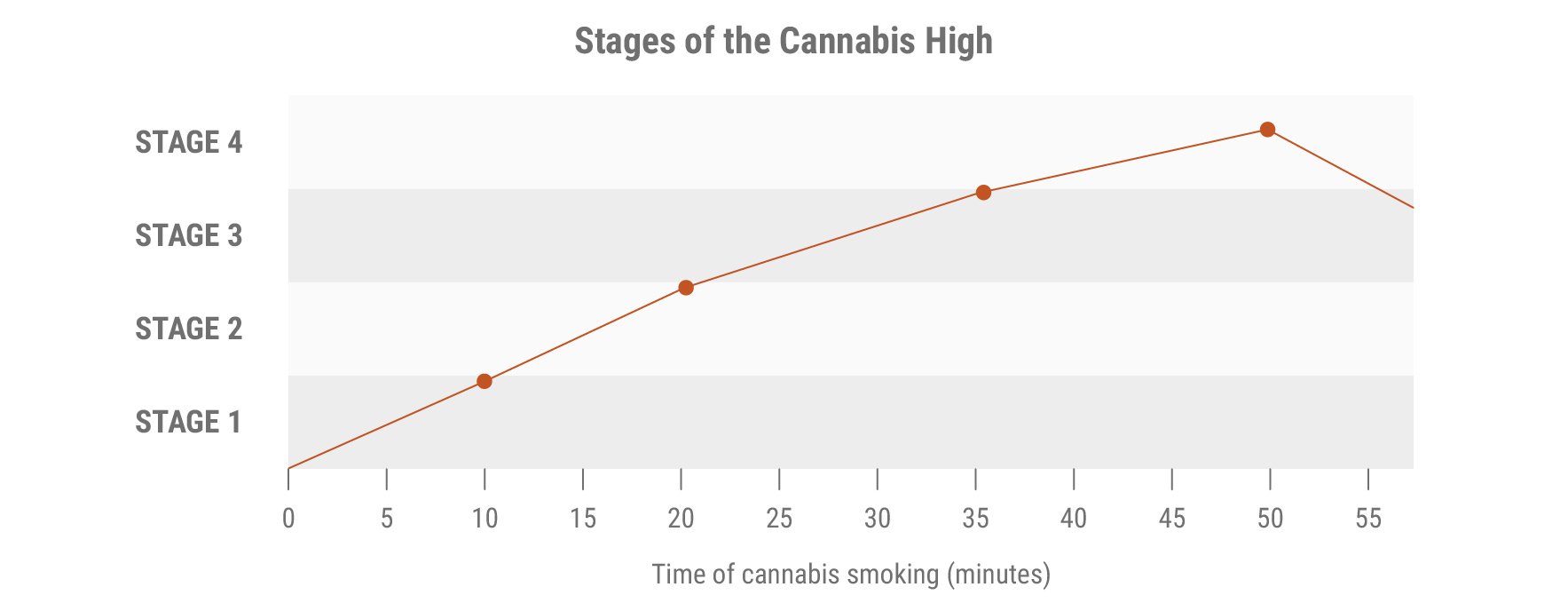
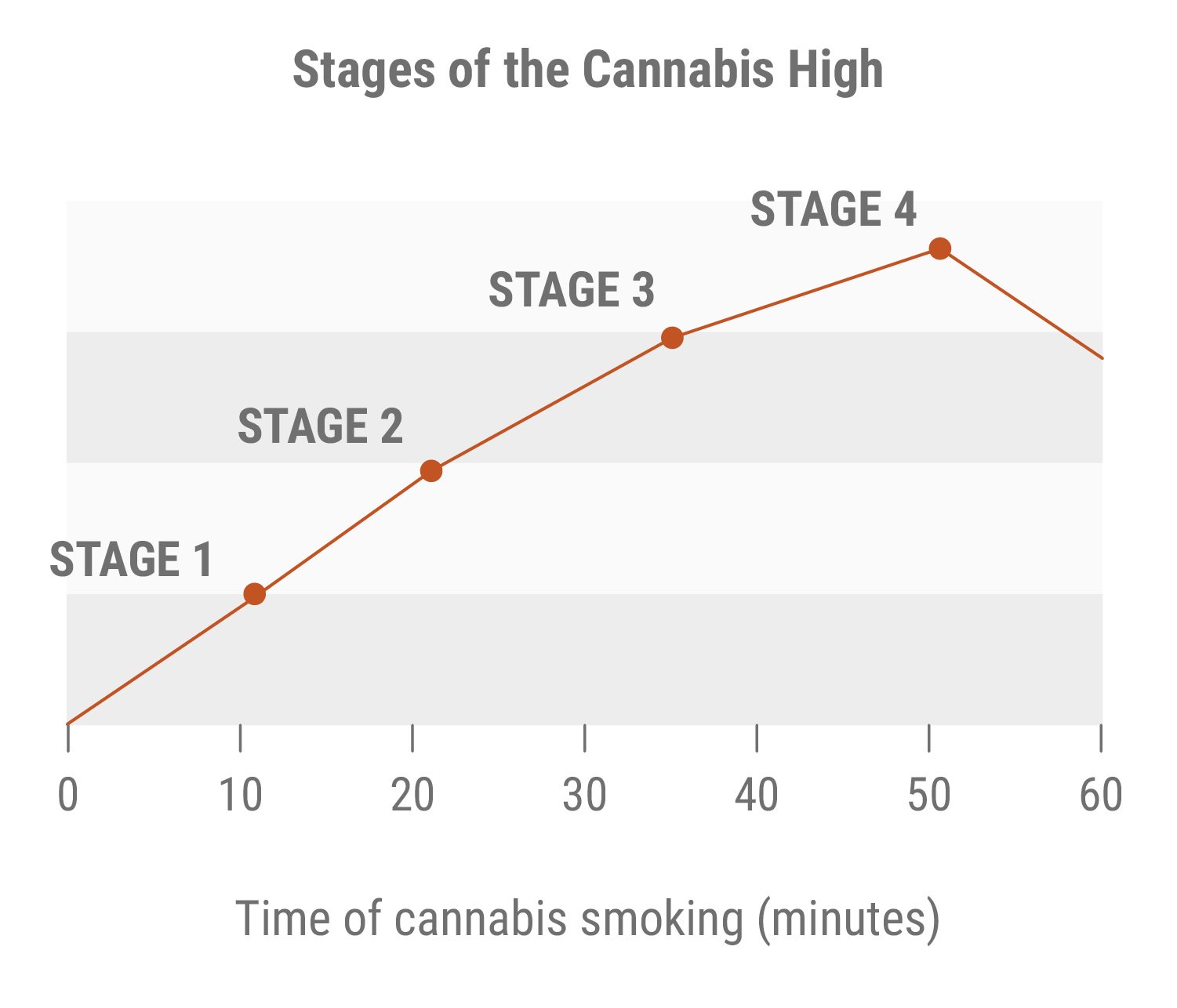
Different Strains Offer Different Highs
In case modern media didn’t let you know, we figured we should mention there are thousands of cannabis strains available. Each cultivar has different phytochemical makeups, along with offering unique psychoactive experiences.
Although the differences are partly due to variations in THC levels, the terpenes contribute to these distinctions as well. Along with underpinning the signature aromas of cannabis, they synergise with THC and other cannabinoids—a phenomenon known as the entourage effect[9]—to modulate the high.
As a result, breeders have made a point of focusing on terpene blends in their new strains. Over time, this serves to greatly expand the pool of available psychoactive experiences.
CBD High Vs. THC High
Along with THC, CBD enhancement is another major focus for breeders. The other main member of the over 100-strong chemical family, CBD produces no psychoactive effects. The molecule has a low affinity for the CB1 receptor, and instead produces a subtle, clear-headed effect that soothes nerves and relaxes the mind.
Interestingly, CBD also affects the CB1 receptor[10], but through indirect means. It reduces an enzyme that breaks down anandamide, causing the endocannabinoid to linger and bind to the site more often. CBD might also help to bring down an unpleasant high by preventing THC from binding to the CB1 receptor.
Different Methods of Consumption Lead to Different Highs
There are many different ways to consume cannabis. While each offers a similar general set of effects, the overall experiences are distinct.
These are the most common consumption methods:
- Smoking/Vaping: The high comes on rapidly, and peaks after about 30 minutes. Since users can take one toke at a time to reach their preferred level, smoking weed is the easiest experience to control. The high typically lasts around 4-8 hours.
- Edibles: Eating cannabis offers a far more intense experience. THC travels through the digestive tract and into the liver. There, the organ converts the molecule into 11-hydroxy-THC, a much more potent and longer-lasting version of the cannabinoid. The edible high takes up to two hours to set in, and lasts up to 12 hours.
- Sublingual: This refers to placing tinctures or oils underneath the tongue. Here, cannabinoids rapidly pass into the bloodstream via the capillaries of the thin tissue. This simple and fast method shares a similar onset and duration to inhaling cannabis.
Mind High vs. Body High
Different cannabis strains produce different highs. These effects all come down to the unique phytochemical cocktails found within each cultivar. Varying levels of cannabinoids and terpenes synergise to create different psychoactive outcomes.
Cannabis strains used to autumn into two primary categories based on their genetics: indica and sativa. Old schools of thought used to pin specific effects on both of these subspecies. Indica strains were thought to be more stoning, whereas sativa strains were assumed to light up the brain.
While these two types of cannabis do feature pronounced differences, new research shows that they rarely have anything to do with the psychoactive effect. Cannabis scientists now suggest the term "chemovar", "chemotype" or "chemical variety", to categories different strains of cannabis together. Although many strains possess the psychoactive cannabinoid THC, it's the more subtle aromatic terpenes that produce such a diversity of effects.
Cultivars can still be divided into stoning or stimulating categories based on their chemovar. For example, strains high in limonene produce more of a head high, whereas those higher in myrcene are more sedating and stoning. Check out the major differences between head and body highs below.
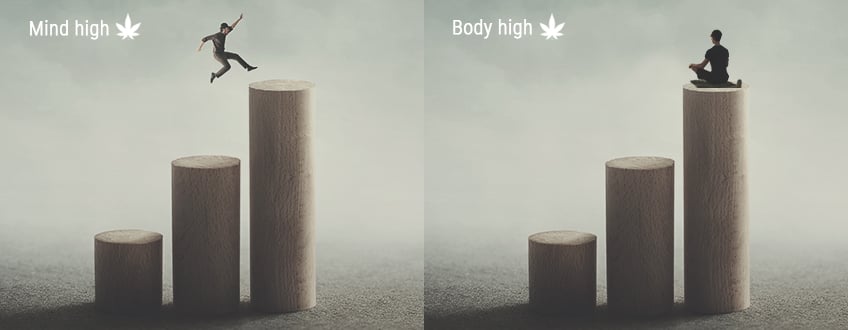
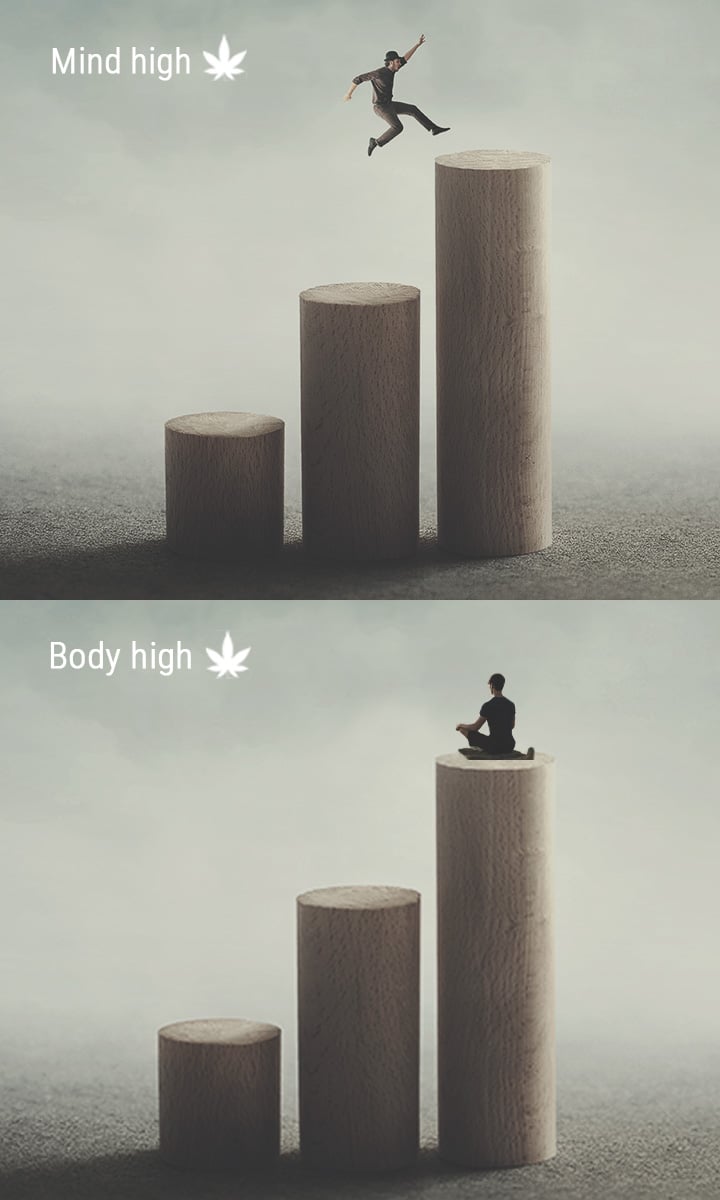
Body high:
- Stoning and relaxing sensation that makes the body feel heavy soothed—perfect for relaxing evening smoke sessions
- “Couch-lock syndrome”, and an overall lack of desire to move around
Head high:
- Mental stimulation, cognitive energy, and alertness—perfect for completing creative projects and enjoying social situations
- The “giggles”, and a desire to joke around.
Why Do People Think Differently When High?
As cannabis temporarily changes the way our mind works, it’s worth considering how that altered state can open us to different ideas.
As we walk around in our day-to-day lives, our minds are mostly locked in a routine thought pattern, which is known as convergent thinking. This mindset encompasses logic, numbers, facts, and linear thinking.
However, cannabis allows many users to leave this rigid structure of thinking[11] and enter a state known as divergent thinking. This state implies heightened creativity and represents a broader and more horizontal structure of thoughts. Cannabis can ultimately widen our perspective, shift the way our brains think, and allows us to imagine and observe things we usually wouldn’t pick up on.
Learn how to boost your high and how weed alters your perception of time
Learn how to boost your high and how weed alters your perception of time
How to compare being stoned, high, and drunk, and how to hide your high
How to compare being stoned, high, and drunk, and how to hide your high
Avoid bad trips, paranoia, and dizziness
Avoid bad trips, paranoia, and dizziness
Check out the best games and movies to experience when high. If you're feeling motivated, learn how to stay motivated when blazed
Check out the best games and movies to experience when high. If you're feeling motivated, learn how to stay motivated when blazed
- The Endocannabinoid System as an Emerging Target of Pharmacotherapy | Pharmacological Reviews http://pharmrev.aspetjournals.org
- THE ENDOCANNABINOID SYSTEM: PHYSIOLOGY AND PHARMACOLOGY | Alcohol and Alcoholism | Oxford Academic https://academic.oup.com
- Endocannabinoid Binding to the Cannabinoid Receptors: What Is Known and What Remains Unknown https://www.ncbi.nlm.nih.gov
- A runner’s high depends on cannabinoid receptors in mice https://www.ncbi.nlm.nih.gov
- The effects of Δ9-tetrahydrocannabinol on the dopamine system https://www.ncbi.nlm.nih.gov
- First Pass Effect - StatPearls - NCBI Bookshelf https://www.ncbi.nlm.nih.gov
- Endocannabinoids and retrograde modulation of synaptic transmission - PubMed https://pubmed.ncbi.nlm.nih.gov
- Default mode network in the effects of Δ9-Tetrahydrocannabinol (THC) on human executive function - PubMed https://pubmed.ncbi.nlm.nih.gov
- Taming THC: potential cannabis synergy and phytocannabinoid-terpenoid entourage effects https://www.ncbi.nlm.nih.gov
- Cannabidiol enhances anandamide signaling and alleviates psychotic symptoms of schizophrenia https://www.ncbi.nlm.nih.gov
- Investigating the interaction between schizotypy, divergent thinking and cannabis use https://www.sciencedirect.com








































